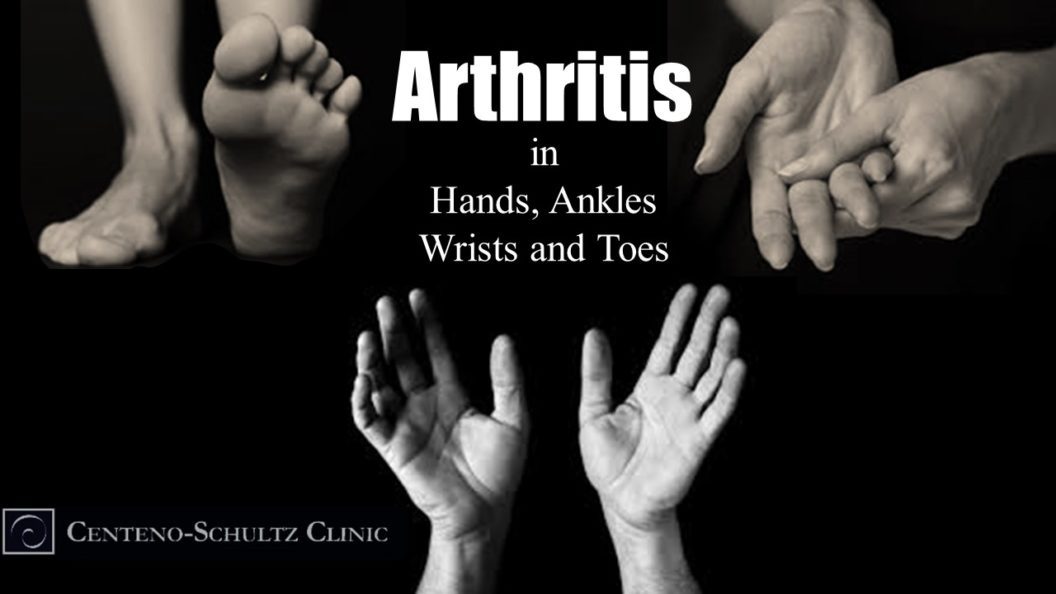During our arthritis series for National Arthritis Month, we’ve talked a lot about the big joints—the knees, hips, and shoulders. But arthritis in smaller joints, such as the hands, ankles, wrists, and toes, can be equally devastating. Today, we’re going to explore arthritis and regenerative treatments, including some patient results and videos, in the ankles and wrists (hands and toes are mentioned as well). Let’s start with the ankles.
Arthritis in the Ankles
Your ankle is located where the distal ends of the tibia and fibula bones (lower-leg bones) meet the talus bone at the foot. Between these bones are the ankle joints (e.g., tibiotalar, tibiofibular, subtalar, etc.). The ankle joint also consists of strong supporting tendons and ligaments. If you consistently experience ankle pain with walking or running or carrying a heavy load, this could be tendon inflammation, ligament instability, or arthritis in one of those joints. By far, ankle instability is the most common cause of ankle arthritis that we experience with patients in our clinic.
Ankle instability occurs when the protective ligaments become stretched out, usually due to a previous ankle sprain or even normal wear and tear. Oftentimes with a sprained ankle, the pain subsides and the patient believes they have recovered, but if those ligaments have stretched out, this can create instability over time. This instability causes the ankle joint to deteriorate, and in time, arthritis develops.
Tackling instability before it becomes ankle arthritis is plan A, and these loose ligaments can be treated without surgery by your interventional orthopedic physician. Watch Dr. Centeno’s video below to learn more:
If your instability has progressed to ankle arthritis, there are regenerative medicine treatments for this as well. Check out this video of a patient who received stem cell treatments for his ankle arthritis (and read his story at this link):
Moving on down the lower limb to the toes, instability due to an old toe injury can also lead to arthritis in the toes. Surgery for toe injuries tends to make matters worse, creating more instability, and leading to faster arthritis down the road. Regenerative medicine solutions can work for the small toe joints with instability or arthritis as well.
Arthritis in the Wrists
The hand and wrist joints may be tiny, but you don’t realize how powerful and important they are until something goes wrong. Suddenly, lifting a pot of water is excruciating, and it all may start with the feeling that your hands are stiff in the morning. Or simple grooming tasks are difficult. Perhaps even writing or using your computer keyboard have become quite painful.
If you take a look at an image of the wrist (see right), it may not make much sense. It appears to be a jumbled mess of tiny fragments of a fractured bone, but there is a functional organization in the assumed chaos.
The wrist is made up of tiny irregularly-shaped bones (collectively called the carpals) that reside between the distal radius and ulna bones (the lower-arm bones) and the metacarpal bones in the hand. These pebble-like bones allow for finger movement in a variety of directions, and the design is extremely complex, making it impossible to surgically replicate the fine details and minute functions of the wrist.
Similar to the ankle, the wrist is also supported and protected by many small ligaments (about 20 or so, again seemingly random but actually extremely precise and complex) that provide for precise and smooth movements. If you didn’t have these ligaments, your hand wouldn’t be able to grasp objects, for example. It’s the complexity of this joint that makes it understandable that it’s impossible to create an artificial wrist replacement that could even come close to providing proper function—this is why the success rates for wrist replacement are so low.
Wrist pain and arthritis, however, can usually be addressed with regenerative medicine treatments using precise advanced orthobiologic injections. The video below shows Dr. Pitts treating hand arthritis, but the preciseness and delicacy of treating small joints would be similar in the wrist:
Arthritis in smaller joints made up of multiple irregularly-shaped structures can be extremely challenging, if not impossible, to treat surgically, and the tiny hand, ankle, wrist, or toe joints post-surgery will never function quite like the original was designed to function. Plan A is to address instability in these small joints via regenerative medicine solutions before they progress to arthritis. If arthritis has set in, this can usually be treated without surgery as well.
Join us this Thursday for our final post in our arthritis series for National Arthritis Month.


